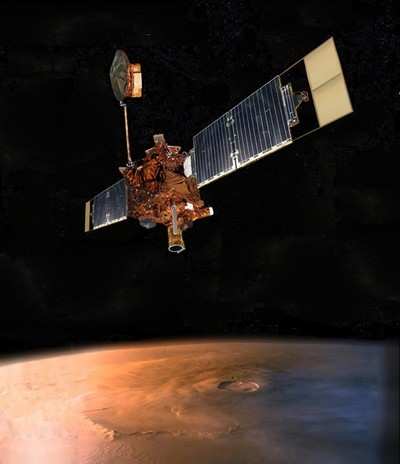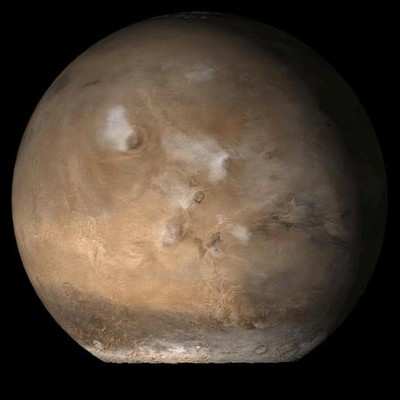Photographs May Indicate Brief Spurts Of Water Since 1999
NASA says photographs taken by the Mars Orbiter Camera on the
now-silent Mars Global Surveyor have revealed bright new deposits
seen in two gullies on Mars... that suggest water carried sediment
through them sometime during the past seven years.

"These observations give the strongest evidence to date that
water still flows occasionally on the surface of Mars," said Dr.
Michael Meyer, lead scientist for NASA's Mars Exploration Program,
Washington.
Liquid water -- as opposed to the water ice and water vapor
known to exist at Mars -- is considered necessary for life. The new
findings heighten intrigue about the potential for microbial life
on Mars. The deposits appear in images the Mars probe took in 2004
and 2005, but not in a 1999 image of one site or a 2001 image of
the other site.
"The shapes of these deposits are what you would expect to see
if the material were carried by flowing water," said Dr. Michael
Malin of Malin Space Science Systems, San Diego. "They have
finger-like branches at the downhill end and are easily diverted
around small obstacles." Malin is principal investigator for the
camera and lead author of a report about the findings published in
the journal Science.
 The atmosphere of Mars is so
thin and the temperature so cold that liquid water cannot persist
at the surface. It would rapidly evaporate or freeze. Researchers
propose that water could remain liquid long enough, after breaking
out from an underground source, to carry debris downslope before
totally freezing.
The atmosphere of Mars is so
thin and the temperature so cold that liquid water cannot persist
at the surface. It would rapidly evaporate or freeze. Researchers
propose that water could remain liquid long enough, after breaking
out from an underground source, to carry debris downslope before
totally freezing.
The two fresh deposits are each several hundred meters long. The
light tone of the deposits could be from surface frost continuously
replenished by ice within the body of the deposit. Another
possibility is a salty crust, which would be a sign of water's
effects in concentrating the salts. If the deposits had resulted
from dry dust slipping down the slope, they would likely be dark,
based on the dark tones of dust freshly disturbed by rover tracks,
dust devils and fresh craters on Mars.
Wednesday's announcement is the first to reveal newly deposited
material apparently carried by fluids after earlier imaging of the
same gullies. The two sites are inside craters in the Terra Sirenum
and the Centauri Montes regions of southern Mars.
"These fresh deposits suggest that at some places and times on
present-day Mars, liquid water is emerging from beneath the ground
and briefly flowing down the slopes. This possibility raises
questions about how the water would stay melted below ground, how
widespread it might be, and whether there's a below-ground wet
habitat conducive to life. Future missions may provide the
answers," said Malin.
Besides looking for changes in gullies, the orbiter's camera
team assessed the rate at which new impact craters appear. The
camera photographed approximately 98 percent of Mars in 1999 and
approximately 30 percent of the planet was photographed again in
2006. The newer images show 20 fresh impact craters, ranging in
diameter from 2 meters (7 feet) to 148 meters (486 feet) that were
not present approximately seven years earlier. These results have
important implications for determining the ages of features on the
surface of Mars. These results also approximately match predictions
and imply that Martian terrain with few craters is truly young.

Mars Global Surveyor began orbiting Mars in 1997. The spacecraft
is responsible for many important discoveries. As Aero-News reported, NASA
has not heard from the spacecraft since early November. Agency
attempts to contact it continue.
 ANN's Daily Aero-Linx (04.16.24)
ANN's Daily Aero-Linx (04.16.24) Aero-News: Quote of the Day (04.16.24)
Aero-News: Quote of the Day (04.16.24) Airborne 04.10.24: SnF24!, A50 Heritage Reveal, HeliCycle!, Montaer MC-01
Airborne 04.10.24: SnF24!, A50 Heritage Reveal, HeliCycle!, Montaer MC-01 Airborne 04.12.24: SnF24!, G100UL Is Here, Holy Micro, Plane Tags
Airborne 04.12.24: SnF24!, G100UL Is Here, Holy Micro, Plane Tags Airborne-Flight Training 04.17.24: Feds Need Controllers, Spirit Delay, Redbird
Airborne-Flight Training 04.17.24: Feds Need Controllers, Spirit Delay, Redbird





